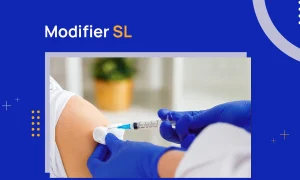In the United States, heart disease is the leading cause of death, claiming one life every 34 seconds. Coronary artery disease (CAD) is the most common type of heart disease and affects around 1 in 20 U.S. adults aged 20 and above. Early detection, treatment, and management can prevent fatalities, and for this reason, diagnostic coronary angiography is a must.
CPT code 93458 describes this procedure. However, cardiologists and their billing teams often find it challenging to select and use this code appropriately for reimbursement collection from insurance payers. Providers forget that besides code selection, modifier application, and billing practices also have an effect on the claim’s acceptance or denial.
In this ultimate guide, we will explore the key details of CPT code 93458 to maximize your chances of clean claim submission and fair payment collection.
CPT Code 93458 Description
The Current Procedural Terminology (CPT) code 93458 is from the ‘Cardiac Catheterization and Associated Procedures’ code range and reports a diagnostic cardiac procedure. Its official description is as follows:
“Catheter placement in coronary artery(s) for coronary angiography, including intraprocedural injection(s) for coronary angiography, imaging supervision and interpretation; with left heart catheterization including intraprocedural injection(s) for left ventriculography, when performed.”
In simple terms, healthcare providers are advised to use this code when they suspect coronary artery disease (e.g., artery blockages) and perform a diagnostic test to assess the blood flow through the coronary arteries and the left side of the heart.
During the test, the healthcare provider inserts a catheter into the femoral artery (groin) or the radial artery (arm) and guides it to the coronary artery using X-ray fluoroscopy. The catheter is a thin, flexible tube that can easily maneuver through the blood vessels to reach the targeted areas and deliver either contrast dyes or therapeutic agents. In the case of CPT code 93458, the targeted area is the coronary artery and left ventricle, while the delivered agent is a contrast dye to ensure better viewing of the heart’s structures and blood vessels during diagnostic imaging.
After injecting the contrast dye through the catheter, the healthcare provider takes several X-ray images (angiograms) to detect any blockages or abnormalities in the coronary artery. If needed, he may even assess the blood flow in the left ventricle. Once the X-ray imaging (angiography) is completed, the provider removes the catheter and applies pressure on the insertion site to stop the bleeding.
Please note that local anesthesia is administered before catheterization to prevent pain and discomfort during insertion.
Appropriate Use Cases for CPT Code 93458
The correct application of CPT code 93458 will help you collect accurate reimbursement for a cardiac catheterization and coronary angiography procedure. Let’s discuss some clinical scenarios where you can appropriately apply CPT code 93458 for insurance billing and reimbursement collection.
To Diagnose Coronary Artery Blockages
Assume that a 55-year-old woman with a family history of coronary artery disease visits the physician’s office complaining of chest pain and shortness of breath. After a physical examination, which includes inquiring about her diet and lifestyle, the physician prescribes cardiac catheterization and coronary angiography to detect or rule out plaque buildup and blockages in the coronary artery.
Hence, the procedure is performed (CPT code 93458), which includes imaging supervision and interpretation. Blockages are identified, and she is recommended to undergo coronary angioplasty or percutaneous coronary intervention (PCI) as a treatment.
To Diagnose Damaged Heart Valves
Imagine that a 60-year-old man visits the physician’s office complaining of chest pain, especially during physical activity, dizziness, fatigue, irregular heartbeat, and even swelling in his feet. He has a history of high cholesterol and two years ago had a minor heart attack. The physician suspects a damaged valve in the left ventricle, due to which oxygenated blood is not being properly pumped to the body.
To confirm his hypothesis, the physician performs cardiac catheterization with angiography (CPT code 93458). Imaging of the left ventricle and surrounding blood vessels reveals stenosis in the left ventricle, causing restricted blood flow from the left ventricle to the aorta. Hence, the patient’s heart is working twice as hard to pump out oxygenated blood. The patient is ordered to undergo surgery as treatment for a later date.
To Diagnose Coronary Artery Aneurysm (CAA)
Suppose that a 32-year-old man visits the physician’s office complaining of chest pain, shortness of breath, fatigue, and lightheadedness. He quickly feels exhausted after a few minutes of physical activity and can even hear his heart murmur. The physician finds out that the patient had Kawasaki disease (KD) in childhood, which was not properly treated. He suspects that inflammation of the blood vessels may have caused a section of the coronary artery to dilate outwards 1.5 times its original size (coronary artery aneurysm).
To confirm his suspicion, the physician performs cardiac catheterization and coronary angiography (CPT code 93458). The imaging results reveal an enlargement in the proximal segment of the left anterior descending (LAD) artery, which limits the heart’s pumping function. Hence, the patient is diagnosed with CAA, and medications are prescribed.
Modifiers to Append with CPT Code 93458
The following modifiers may be appended to CPT code 93458 to highlight the special circumstances in which the procedure was performed and prevent instances of under- or non-payments.
Modifier 26
Many diagnostic procedures, such as radiology, pathology, and laboratory tests, can be broken down into professional and technical components for separate reimbursements. When this happens, appropriate modifiers are used to alert the insurance payer so that only the payment corresponding to that component is released. For example, modifier 26 is appended to CPT code 93458 when the healthcare provider is seeking payment for the professional component of the procedure. In other words, he is claiming reimbursement for the supervision of angiography and interpretation of angiograms.
Modifier TC
In contrast, when the facility is only charging for the technical component of cardiac catheterization and coronary angiography, modifier TC is appended to CPT code 93458. It means that the insurance payer must reimburse the technician’s time, skills, and the equipment used.
Modifier 51
Modifier 51 indicates multiple procedures performed in the same session. So, if two distinct procedures were performed in the same session, modifier 51 can be used with the second procedure’s code for separate reimbursements. For example, if a PCI stent placement (CPT code 92928) and cardiac catheterization (CPT code 93458) were performed one after another, modifier 51 will be appended to 93458.
Modifier 59
However, if the patient receives two distinct services on the same service date, modifier 59 is used to explain this and prevent claim duplication-related denials.
You must note that the Centers for Medicare and Medicaid Services (CMS) discourages overusing modifier 59 and recommends using its subsets X{EPSU} instead. So, in this case, modifier XU will be more appropriate to highlight that the two services are distinct because their usual components do not overlap.
Besides these general CPT modifiers, the CMS recommends appending coronary artery modifiers to help the payer identify the vessel on which cardiac catheterization and angiography were performed.
| Coronary Artery Modifier | Description |
|---|---|
| LC | Left circumflex coronary artery |
| LD | Left anterior descending coronary artery |
| LM | Left main coronary artery |
| RC | Right coronary artery |
| RI | Ramus intermedius |
Reimbursement Guidelines for CPT Code 93458
Filing error-free claims that are accepted on the first attempt is only possible when you follow the billing best practices. In this section, we will discuss some key reimbursement guidelines specific to CPT code 93458.
Justify the Medical Necessity
First and foremost, you must justify the medical necessity of a cardiac catheterization with angiography to the insurance payer. The payer must understand why the procedure was performed and how it impacted the patient’s well-being. You can do this through:
Correct ICD-10 Code Pair
ICD-10 codes help the payer understand the patient’s condition and symptoms. In the case of CPT code 93458, you can explain the need for cardiac catheterization and angiography with the following ICD-10 codes.
- I20.0 – Unstable angina
- I20.1 – Angina pectoris with documented spasm
- I20.81 – Angina pectoris with coronary microvascular dysfunction
- I24.0 – Acute coronary thrombosis not resulting in myocardial infarction
- I25.3 – Aneurysm of the heart
- I25.41 – Coronary artery aneurysm
The CMS also provides a complete list of ICD-10 diagnosis codes that support left heart catheterization with coronary angiography.
Detailed Documentation
You must also provide complete and accurate documentation to support the medical necessity of the procedure. These include patients’ updated medical records, clinical notes, procedural notes, referral letters, imaging results and reports, specifying the insertion site and the catheterized blood vessel, etc.
The payer may also ask for additional supporting documents after you have submitted the claim. When this happens, respond to their request promptly.
Do Not Bill Anesthesia Separately
Local anesthesia is included or bundled into CPT code 93458. Therefore, an anesthesia code should not be used on the same claim for separate reimbursement.
Use the Appropriate Modifiers
As discussed extensively, modifiers should be used (when needed) with CPT code 93458 to explain special circumstances such as multiple procedures or billing for a single component. Note that missing modifiers can trigger claim denials.
Confirm Reimbursement Rates
Before entering the charges, you must confirm the reimbursement rate set by each payer. The same payer may have varying rates based on facility settings.
For example, when cardiac catheterization with angiography (CPT code 93458) is performed in an ambulatory surgical center (ASC), Medicare pays $1,546. However, when the same session is performed in a hospital outpatient department, Medicare reimburses $2,574. This is because the facility fee for an ASC is $1,655. But the hospital charges twice as much, $3,216, for its facilities, even though the physician fee remains the same – $277.
Review Payer-Specific Policies
You must also carefully review each insurance payer’s billing policies to understand what is acceptable and what isn’t. For example, while commercial payers may allow you to unbundle two procedures for separate reimbursements, Medicare may restrict it through its NCCI edits.
Final Thoughts on CPT Code 93458
CPT code 93458 is frequently used in cardiology to detect coronary artery disease and related conditions early on. This diagnostic procedure, represented by code 93458, can prevent fatalities arising from heart disease. That is why you must learn to use this code correctly and collect reimbursements against it.
We understand that ensuring flawless medical billing and coding is easier said than done. That is why we recommend professional cardiology billing services from experts at NeuraBill. They can take over your non-clinical duties, so you, too, can enjoy effortless revenue increase.



